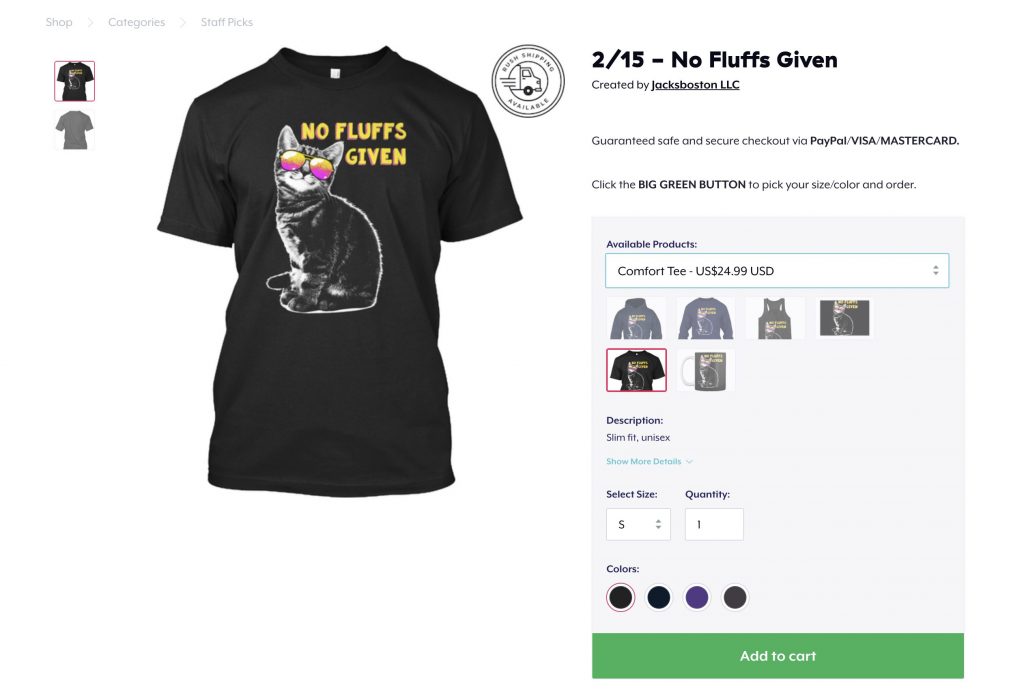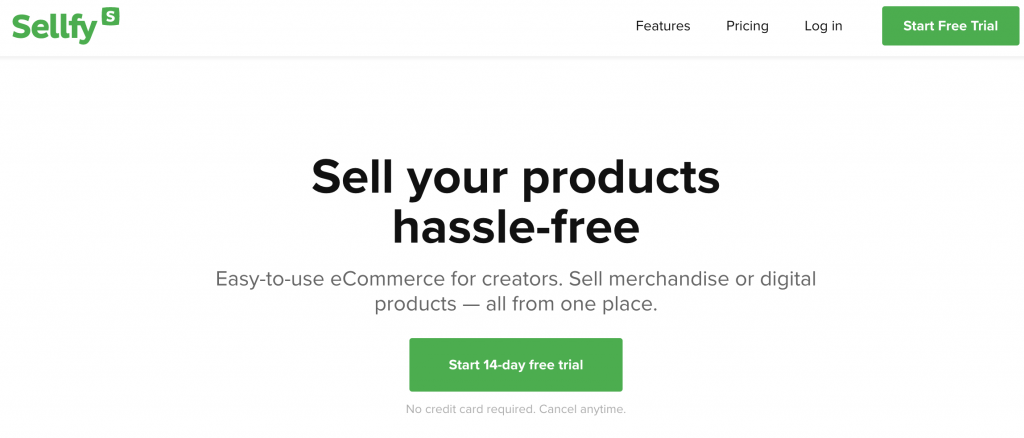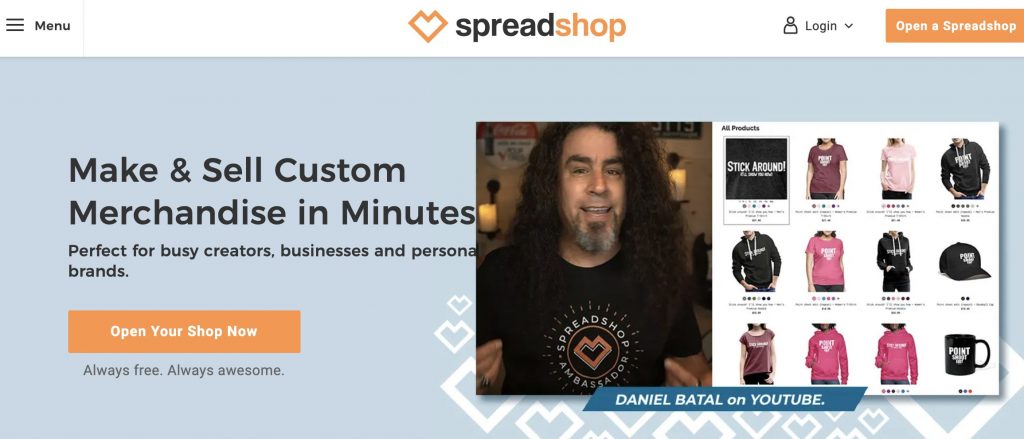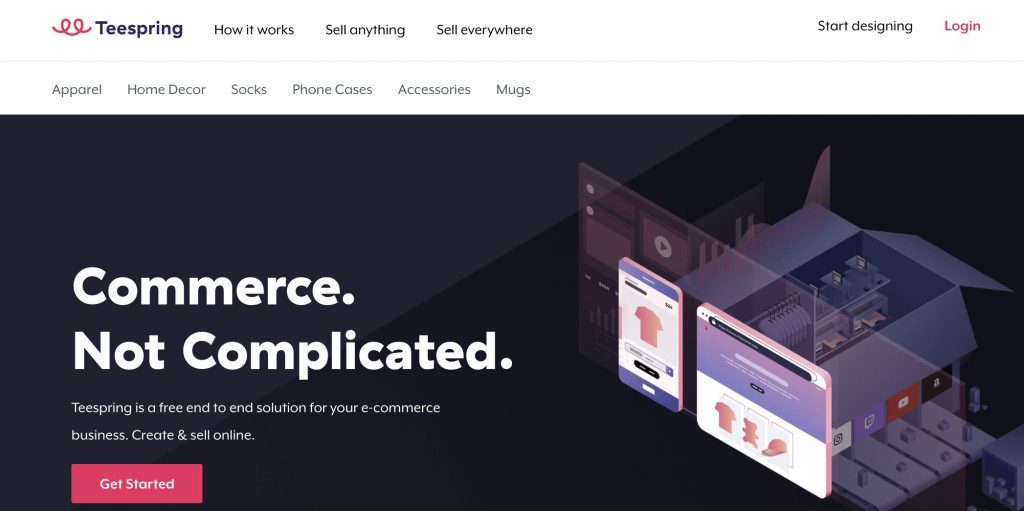If you’ve always wanted to enter the fashion industry, selling T-shirts is a good place to start. It might not sound that extravagant, but the industry shows a lot of potential. According to data shared by Grand View Research, the custom printing T-shirt market was valued at nearly $4 billion in 2020 and is set to grow at a compound annual growth rate of almost 10% in the next seven years.
Whether you want to wear it for branding purposes or to communicate individual interests, it’s the versatility of this wardrobe staple that makes it so easy to sell online. Consumers love customization. And with print-on-demand services, you can offer them a range of designs that they actually want. From identifying the ideal customer to selecting a marketing strategy, here’s how you can launch a successful T-shirt business in nine easy steps. We’ve also included a few of our favorite print-on-demand services that you can check out.
Creating an Online T-shirt Business with Print-on-demand in Under 10 Steps:
- What’s Print-on-demand?
- 1. Pick a market
- 2. Get to know your niche and competition
- 3. Build your eCommerce store
- 4. Integrate with a print-on-demand service
- 5. Get designing (again)
- 6. Check the quality
- 7. Create a few mockups and get feedback
- 8. Decide on a price
- 9. Market your brand and its products
- Top Print-on-demand Services
- Frequently Asked Questions
What’s Print-on-demand?
In short, print-on-demand is a type of dropshipping. This way, you can create and sell unique T-shirt designs without having to worry about fulfillment, shipping, or inventory. After a customer has placed an order for one of your tees, the print-on-demand service will print the T-shirt and ship it directly to the customer. Not only does this cut down on the workload, but it also allows you to start an online store without a huge upfront investment.
9 Steps to Starting an Online T-shirt Buiness
1. Pick a market
One of the fundamental rules of selling products online is that you need to have a niche. While T-shirts are an essential item for any wardrobe, not everyone will necessarily want to buy your T-shirts. So, to ensure that you attract the right crowd for your designs, start by identifying your ideal target audience.
The trick is not to make it too general. What are you passionate about? What are your personal interests? You can use your passions and interests as a starting point.
Alternatively, you can look at what’s currently trending. You can, for example, use Google Trends to identify the most popular search terms and use this info to identify a niche.

Source: teespring.com
2. Get to know your niche and competition
Once you’ve identified your niche, you need to get to know your target audience. What do they like to post online? Which type of content attracts better engagement? This information can help you to come up with possible T-shirt designs.
Not only should you get to know your niche better, but you should also vet your competition. What are they doing that seems to get results? Are they perhaps missing a section of your niche that you can make your focus?
3. Build your eCommerce store
It’s very tempting to create your online store first, but the groundwork that you’ve done in the previous steps is crucial to help you set up your print-on-demand business for success from the get-go.
There are numerous eCommerce platforms like Shopify and BigCommerce that you can check out to create your online store and a number of print-on-demand services offer direct integration with these platforms. So, when deciding on your platform and print-on-demand service, you’ll want to double-check that these two integrate. This way, you’ll be ready to process orders much faster. It’s also a good idea to select a platform that integrates with other sales platforms such as Instagram, Facebook, or even Amazon.
In addition to integrations, you’ll also want to check out the design capabilities of the platform. You’ll want to select one that offers enough customization so that you can create an online store that reflects your brand. A good platform will offer several templates that are easy to customize to match your branding.
However, even if your website is beautifully designed but fails in the user-friendly department, most of your efforts will be in vain. Considering that mobile shopping accounts for most online sales nowadays, you’ll need to ensure that whichever template you pick is optimized for mobile.
4. Integrate with a print-on-demand service
Once you’ve created your website, you can now connect your online store to the print-on-demand service of your choice. This way, you’ll be able to sell your T-shirts from your own website.
Not only do print-on-demand services require little startup cost, but most also offer mockup generators so that you can see what your design will look like on the T-shirt and what the final product will look like on a model. This is a very useful feature as you can use these images as product images on your actual website too.
5. Get designing (again)
With the website out of the way, you can finally start with the other part that you need to design – your actual custom tees. To grab the attention of your target audience, your designs need to be original, yet simple. You can, for example, include slogans, illustrations, or a message. These are all examples of popular T-shirt designs.
Depending on your own artistic abilities, you can either sketch your ideas or hire the help of a professional graphic designer. Either way, it’s best to start the process with hand-drawn designs and then take it from there. In fact, depending on the style that you’re going for, you can possibly turn your hand-drawn designs into vectors that you can tweak a bit.
The print-on-demand service that you’ve selected will have its own requirements. So, just make sure that whatever you design will meet these guidelines.
6. Check the quality
As you’ll be selling your T-shirts online, you’ll want to make sure that the quality of your products meet your audience’s expectations. This will be a real deal-breaker for the success of your venture.
Sure, you can opt for lower quality material to boost your profit margins. Though, this will only hurt your brand in the long run. Plus, considering that returning customers can be the lifeblood of eCommerce businesses, you’ll want to do everything in your power to ensure that customers return to your store again and again and again.
So, it’s important that you order a couple of samples before you start selling your T-shirts to the world. You’ll want to look at the quality of the material as well as the sizing and how it fits. No one likes having to buy an extra large when they’re really just a medium.
You’ll also want to check what the T-shirt looks like after washing it. Does the color fade easily just after one wash? Worse yet, did it perhaps shrink?
Look at the actual print as well. You don’t want your designs to show signs of cracking. It’s definitely not the type of vintage look that will get you good reviews and returning customers.
Nowadays, sustainability is also key for consumers and it will start to play an even bigger factor in the future. Online surveys have found that not only will customers change brands to reduce their environmental footprint, but many are also willing to pay more for brands that do their bit for the planet.
So, while T-shirts made from more eco-friendly materials, such as organic cotton, might cost more, it can end up being profitable. Not only can you use it as a unique selling proposition, but you can rest assured knowing that you’re part of the solution.
7. Create a few mockups and get feedback
Now it’s time to see how your designs and their “blank canvases” come together. This step is important not only for you, but also for your target audience who’ll ultimately want to see what the final design actually looks like.
As mentioned earlier, many print-on-demand services have a mockup generator. You can use this feature to create product images that you can share on social media platforms like Facebook and Instagram to get feedback from your followers. You can also share it in Facebook groups to find out what your target audience thinks before you continue full steam ahead. This is one of the major perks of going the print-on-demand route as you can get affirmation of the work that you’ve put in thus far without necessarily having to spend a small fortune on printing stock that simply doesn't sell.
When sharing your mockups with your followers and target audience, it’s also a good idea to include a product description. You’ll have to write these sooner than later and it can be a great way to get the word out about your designs and brand quite literally.
8. Decide on a price
On average, custom T-shirts sell for anything from about $15 to $30. For something that’s more unique, such as a limited edition T-shirt design, or an overall better quality product, you can ask as much as $40.
Though, you’ll first want to work out your costs before you simply decide to charge the average asking rate. All things considered, the majority of businesses in this niche try to generate more or less 50% profit per item. Typical expenses that you’ll have when you run an online business with print-on-demand include:
- Website hosting
- Domain
- Graphic design fees
- Print-on-demand fees
- Marketing
You’ll also need to complete some market research when deciding on your selling price. What are competitors asking for similar designs?
The risk of pricing it too low is that it will be more challenging to generate a decent profit if you don’t manage to sell loads of T-shirts. That being said, when done right, it can work in your favor to charge slightly less than your rivals. This pricing strategy can help you to get the attention of new customers and set yourself apart from similar brands.
9. Market your brand and its products
Even the best designs won’t sell themselves. You’ll need to create a memorable brand and spread the word about your designs on social media.
One of the most effective eCommerce marketing strategies for selling T-shirts online is to use influencer marketing. Micro-influencers can generate better conversions as their followers are usually more engaged. So, even if the influencer has only a few hundred followers, they can still create enough exposure. When going this route, you can, for example, offer these influencers free T-shirts in exchange for sharing content in which they wear your creations.
In addition to working with influencers, you can also use SEO tools. By including relevant keywords in your product descriptions, it can help potential customers to find your website easier.
That being said, you shouldn’t rely solely on your own website. Social media is where virtually everything happens, including sales. Therefore, you’ll also want to ensure that your designs are visible on all the social media channels where your target audience hangs out often.
Top Print-on-demand Services
Sellfy
With Sellfy, you can sell physical products, like T-shirts and other apparel, as well as digital products. It will automatically print any incoming T-shirt orders and ship it to your customers.
It offers a lot more than merely print-on-demand services. One of its useful features if you’re just starting out is that it offers different marketing tools. You can, for example, use its platform to create discount codes, upsell at checkout to make more money, and integrate with Facebook.
All in all, the platform is easy to use. From customizing your storefront to getting paid via your preferred payment processor, there’s no need for any coding skills. Another major perk is that it doesn’t charge any transaction fees. From as little as $29 per month (or $19 if you choose to get billed annually), you can start to sell your designs.
Spreadshop
Founded in 2017, Spreadshop is still relatively new. However, its print-on-demand service is powered by Spreadshirt that has been doing demand custom printing for nearly two decades.
With the help of Spreadshop, entrepreneurs and creators can start their own fully individualized online store to start selling clothing and other merch. The platform will give you suggested retail prices, but you still remain in control of your final price.
One of the attractive features of Spreadshop is that if you increase your volume, you can get the item for a lower base price. It offers a performance bonus automatically to shop owners who sell more than 50 items per month. According to its website, its shop owners sell over 120 T-shirts on average per month. So, the chances are very good that you'll qualify for this reduced pricing.
Unlike other platforms, it also offers affordable design services as an add-on. So, if you don’t feel confident in your own artistic abilities, but don’t necessarily want to find your own graphic designer, you can let Spreadshop add the missing touches to your designs.
Overall, the interface is great. Not only is it more intuitive than many, but it’s also more efficient. The best part – it’s completely free. No subscription charges whatsoever.
Teespring
If marketing is not your strong suit or passion, Teespring offers a variety of free built-in marketing tools to help you scale your business. For starters, you’ll get access to its boosted network. Behind the scenes, it integrates with seven different online marketplaces to offer its users multiple sales channels. In other words, your T-shirts will pop up on a marketplace like Amazon without you having to worry about more work. In addition, it also offers retargeting as well to remind a potential customer about your products again if they don’t buy it immediately after seeing it the first time.
While it’s great for marketing, it doesn’t offer the best customization. It’s more about selling products than offering a customer experience.
However, what it lacks in customization, it makes up for in shipping options. Another notable feature of Teespring is that it offers same-day printing and two-day shipping options.
So, if you want to focus more on your products than creating a full-scale online retail store, Teespring can help you to spring into action. Just like Spreadshop, it’s free for creators to use. As its fee is included in the base cost of the product, you simply set your selling price and keep all of the profit.
Wrapping Things Up
For a long time, YouTubers and other celebrities have been selling their own merch online. Now, with the availability of print-on-demand services and its ease of use, basically anyone can sell custom clothing online.
T-shirts, in particular, can be a great place to start. The T-shirt industry is booming and with very good reason. With a clever slogan or creative message, this modest item can make a fashion statement of a different kind.
Frequently Asked Questions
Is print-on-demand a good model to use?
Print-on-demand can be a great way to make money and earn a profit on products. As you don’t touch the product once it has been ordered through your online store, getting started is simple. Plus, as you won’t have to buy inventory, your startup costs and overhead expenses will also be lower. All things considered, it’s less risky as opposed to other models. You can invest in more designs without running the risk of discovering only later that these items don’t sell.
Are there any free print-on-demand services?
Yes, you can, for example, check out Teespring and Spreadshop. With both these services, you can create an account, upload designs and begin to sell without taking any financial risk. They make money by keeping a portion (instead of a percentage) of the total sale price. It charges a fixed fee per item and then users can set whichever price they want to charge for the item.
Is Teespring good?
Teespring offers a big selection of products to sell, but one con is that it offers limited styling of text on products. Its storefronts also don’t offer a lot of customization. You can use it to sell products, but it’s not enough to create a memorable customer experience. That being said, its perks outweigh these drawbacks. It offers same-day printing and two-day shipping options which are major advantages. What’s more, without having to opt-in, it will integrate with seven different online marketplaces.
What are some of the most profitable eCommerce business ideas?
Selling fashion items online is one of the most profitable eCommerce business ideas. In fact, T-shirts in particular are one of the most trending business ideas on Shopify and print-on-demand lifestyle apparel are one of the top eCommerce niche ideas.
Can you make money by selling online custom T-shirts?
According to data gathered by Grand View Research, the custom printing T-shirt market was valued at almost $4 billion in 2020. What’s more, it’s set to grow at a compound annual growth rate of almost 10% in the next seven years. On average, custom T-shirts can sell for anything from about $15 to $40. Plus, if you use print-on-demand services, your startup costs are lower and the risks fewer.





